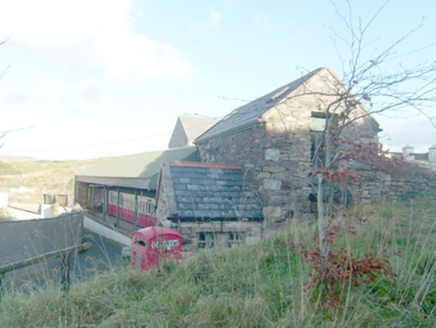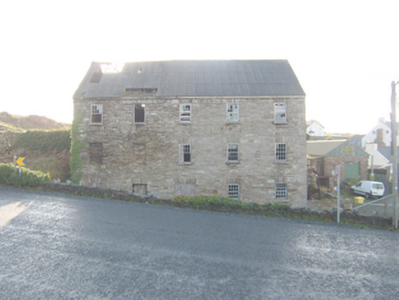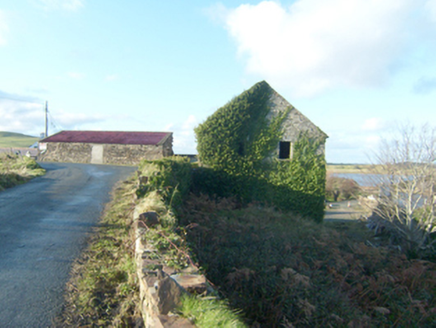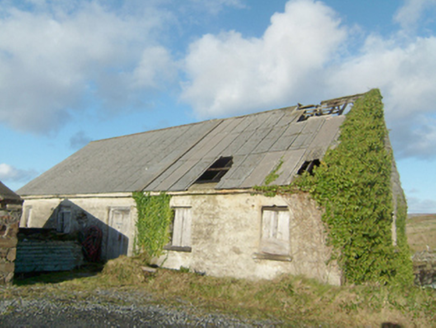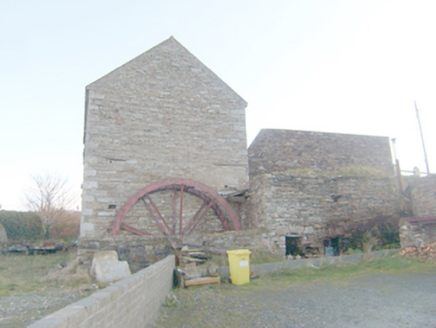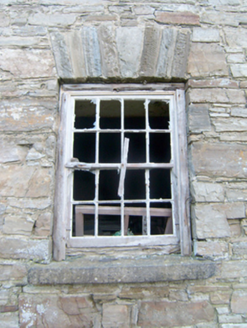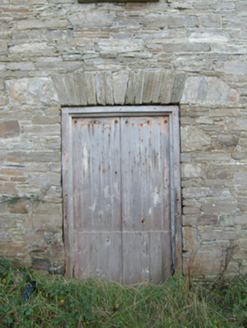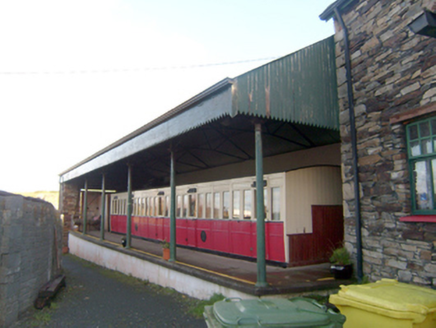Survey Data
Reg No
40901523
Rating
Regional
Categories of Special Interest
Architectural, Social, Technical
Original Use
Mill (water)
In Use As
Hostel
Date
1780 - 1790
Coordinates
199807, 435532
Date Recorded
15/11/2010
Date Updated
--/--/--
Description
Detached five-bay three-storey former corn mill, built c. 1789, having remains of metal waterwheel attached to the west gable end, and with single-storey block to the rear (south) at the west corner, possibly a former corn kiln. Single-storey elevation addressing road to the south. Now out of use and derelict. Pitched corrugated-cement sheeted roof having projecting cut stone eaves course; roof now partially collapsing. Coursed and roughly squared rubble sandstone walls with flush roughly dressed block-and-start quoins to the corners; roughcast rendered walls to the east and south elevations. Square-headed window openings having stone sills, roughly squared rubble stone voussoirs, and remains of eight-over-eight pane timber sliding sash windows; some window openings to the north elevation now blocked with rubble stone masonry and window openings to the south elevation now boarded. Square-headed doorways with battened timber doors. Set back from road in own grounds in the rural country side to the south-west of Dunfanaghy, overlooking New Lake to the north. Rubble stone walls surrounding waterwheel pit to the west elevation; rubble stone retaining walls to the north and south of site. Attached single-storey outbuilding to the south-west having no roof, rubble stone walls, and square-headed openings with timber lintels and rubble stone voussoirs. Former millrace to the west running south-to-north. Single-storey outbuilding to the south having mono-pitched corrugated metal roof with raised rendered verges to gable ends (north and south, rubble stone walls. Series of structures to south-west including modern and conserved buildings. Former railway platform with mono-pitched roof supported on cast-iron columns; restored railway carriage, now in use as a hostel, to former railway platform. Large modern guest house building etc. to the south-west.
Appraisal
This appealing and imposing former corn mill complex retains its early form and character despite being currently out of use and derelict. It also retains much of its early fabric including timber sliding sash windows, and battened timber doors. It is robustly-constructed in local rubble stone masonry with good quality quoins to the corners. Its continued survival in relatively good condition is testament to its robust construction. Of particular interest and importance is the survival of the iron undershot waterwheel to the west, which provides an interesting insight in historical industrial methods. Much of the originally machinery also survives to the interior (not viewed) including mill stones and a variety of machinery. A flagstone floor survives to the ground floor. It is relatively unusual in arrangement being three-storeys to the north and single-storey to the south, making good use of the falling ground. This mill was apparently built in 1789 by the Stewart family (perhaps of Horn Hill house), proprietors of large estates in the area from the late-eighteenth century into the twentieth century. The Stewarts also built a number of other mills in the area (particularly scutching mills) a number of lime kilns, and the market house in Dunfanaghy (1844), providing a market place for local produce. The block adjacent to the south was possibly corn drying kiln(s). It was probably originally a ‘toll mill’ where grain was milled in return for a toll or payment. The mill served the domestic and farm needs of a wide area, apparently including the islands. According to local tradition, the mill became a meeting point for the local community etc. who entertained each other with song, poetry, storytelling, dance etc. while they waited for their grain to be milled (half a day). The mill apparently remained in use until as recently as 1965. A John McVeigh was the miller here in 1881 and 1894 (Slater’s Directory). This complex originally dates to the late-eighteenth century, a period that saw a great boom in the Irish corn milling industry. The waterwheel was powered by a headrace using water stored in a large mill pond adjacent to the south. This building is an important element of the built heritage of the Dunfanaghy local area, and of the industrial archaeology of Donegal. Sensitively restored, it would make a strongly positive contribution to the rural landscape to the south-west of Dunfanaghy.
